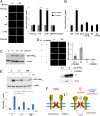Mechanical stress-activated integrin α5β1 induces opening of connexin 43 hemichannels
- PMID: 22331870
- PMCID: PMC3295295
- DOI: 10.1073/pnas.1115967109
Mechanical stress-activated integrin α5β1 induces opening of connexin 43 hemichannels
Abstract
The connexin 43 (Cx43) hemichannel (HC) in the mechanosensory osteocytes is a major portal for the release of factors responsible for the anabolic effects of mechanical loading on bone formation and remodeling. However, little is known about how the Cx43 molecule responds to mechanical stimulation leading to the opening of the HC. Here, we demonstrate that integrin α5β1 interacts directly with Cx43 and that this interaction is required for mechanical stimulation-induced opening of the Cx43 HC. Direct mechanical perturbation via magnetic beads or conformational activation of integrin α5β1 leads to the opening of the Cx43 HC, and this role of the integrin is independent of its association with an extracellular fibronectin substrate. PI3K signaling is responsible for the shear stress-induced conformational activation of integrin α5β1 leading to the opening of the HC. These results identify an unconventional function of integrin that acts as a mechanical tether to induce opening of the HC and provide a mechanism connecting the effect of mechanical forces directly to anabolic function of the bone.
Conflict of interest statement
The authors declare no conflict of interest.
Figures




Similar articles
-
Direct regulation of osteocytic connexin 43 hemichannels through AKT kinase activated by mechanical stimulation.J Biol Chem. 2014 Apr 11;289(15):10582-10591. doi: 10.1074/jbc.M114.550608. Epub 2014 Feb 22. J Biol Chem. 2014. PMID: 24563481 Free PMC article.
-
14-3-3θ facilitates plasma membrane delivery and function of mechanosensitive connexin 43 hemichannels.J Cell Sci. 2014 Jan 1;127(Pt 1):137-46. doi: 10.1242/jcs.133553. Epub 2013 Oct 25. J Cell Sci. 2014. PMID: 24163432 Free PMC article.
-
Mitogen-activated Protein Kinase (MAPK) Activated by Prostaglandin E2 Phosphorylates Connexin 43 and Closes Osteocytic Hemichannels in Response to Continuous Flow Shear Stress.J Biol Chem. 2015 Nov 20;290(47):28321-28328. doi: 10.1074/jbc.M115.683417. Epub 2015 Oct 6. J Biol Chem. 2015. PMID: 26442583 Free PMC article.
-
The Role of Connexin Channels in the Response of Mechanical Loading and Unloading of Bone.Int J Mol Sci. 2020 Feb 9;21(3):1146. doi: 10.3390/ijms21031146. Int J Mol Sci. 2020. PMID: 32050469 Free PMC article. Review.
-
Connexin 43 hemichannels and prostaglandin E2 release in anabolic function of the skeletal tissue to mechanical stimulation.Front Cell Dev Biol. 2023 Apr 13;11:1151838. doi: 10.3389/fcell.2023.1151838. eCollection 2023. Front Cell Dev Biol. 2023. PMID: 37123401 Free PMC article. Review.
Cited by
-
The osteocyte: an endocrine cell ... and more.Endocr Rev. 2013 Oct;34(5):658-90. doi: 10.1210/er.2012-1026. Epub 2013 Apr 23. Endocr Rev. 2013. PMID: 23612223 Free PMC article. Review.
-
Role of connexins and pannexins during ontogeny, regeneration, and pathologies of bone.BMC Cell Biol. 2016 May 24;17 Suppl 1(Suppl 1):19. doi: 10.1186/s12860-016-0088-6. BMC Cell Biol. 2016. PMID: 27230612 Free PMC article. Review.
-
Connexin43 in Musculoskeletal System: New Targets for Development and Disease Progression.Aging Dis. 2022 Dec 1;13(6):1715-1732. doi: 10.14336/AD.2022.0421. eCollection 2022 Dec 1. Aging Dis. 2022. PMID: 36465186 Free PMC article.
-
Cx43 and mechanotransduction in bone.Curr Osteoporos Rep. 2015 Apr;13(2):67-72. doi: 10.1007/s11914-015-0255-2. Curr Osteoporos Rep. 2015. PMID: 25616771 Free PMC article. Review.
-
c-Abl regulates YAPY357 phosphorylation to activate endothelial atherogenic responses to disturbed flow.J Clin Invest. 2019 Mar 1;129(3):1167-1179. doi: 10.1172/JCI122440. Epub 2019 Feb 11. J Clin Invest. 2019. PMID: 30629551 Free PMC article.
References
-
- Robling AG, Castillo AB, Turner CH. Biomechanical and molecular regulation of bone remodeling. Annu Rev Biomed Eng. 2006;8:455–498. - PubMed
-
- Alford AI, Jacobs CR, Donahue HJ. Oscillating fluid flow regulates gap junction communication in osteocytic MLO-Y4 cells by an ERK1/2 MAP kinase-dependent mechanism. Bone. 2003;33:64–70. - PubMed
Publication types
MeSH terms
Substances
Grants and funding
LinkOut - more resources
Full Text Sources
Molecular Biology Databases

